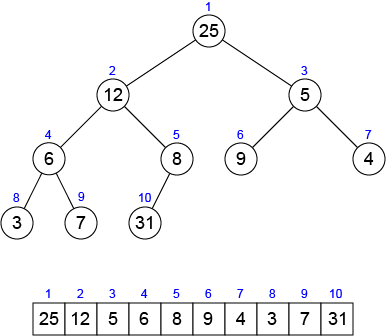Complete Binary Tree
A complete binary tree is a binary tree in which every internal node has two children and all leaves have the same depth. A binary tree in which if last level is not completely filled but all nodes (leaves) are pushed across to the left, is also (nearly) a complete binary tree.
A binary heap data structure is an array that can be viewed as a nearly complete binary tree as shown in the following figure.

Each node of a nearly complete binary tree corresponds to an element of the array that stores the value in the node. An array A that represents a binary heap has the heap size H, the number of elements in the heap, and each element of the binary heap is stored into A[1...H] respectively. The root of the tree is A[1], and given the index ii of a node, the indices of its parent parent(i), left child left(i), right child right(i) can be computed simply by ⌊i/2⌋, 2×i and 2×i+1respectively.
Write a program which reads a binary heap represented by a nearly complete binary tree, and prints properties of nodes of the binary heap in the following format:
node id: key = k, parent key = pk, left key = lk, right key = rk,
id, k, pk, lk and rk represent id (index) of the node, value of the node, value of its parent, value of its left child and value of its right child respectively. Print these properties in this order. If there are no appropriate nodes, print nothing.